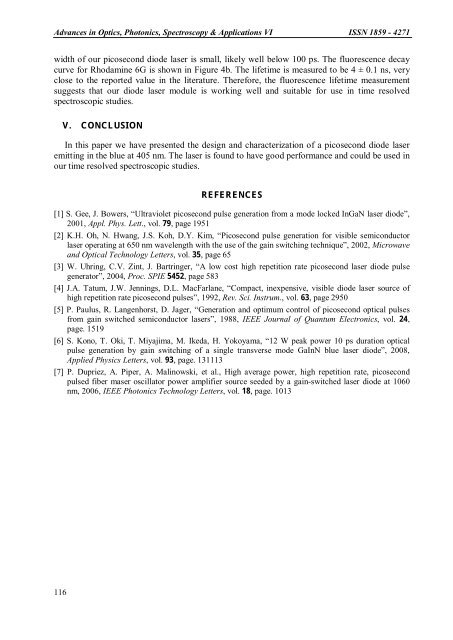Advances in Optics, Photonics, Spectroscopy & Applications <strong>VI</strong> <strong>ISSN</strong> <strong>1859</strong> - <strong>4271</strong>width of our picosecond diode laser is small, likely well below 100 ps. The fluorescence decaycurve for Rhodamine 6G is shown in Figure 4b. The lifetime is measured to be 4 ± 0.1 ns, veryclose to the reported value in the literature. Therefore, the fluorescence lifetime measurementsuggests that our diode laser module is worki<strong>ng</strong> well and suitable for use in time resolvedspectroscopic studies.V. CONCLUSIONIn this paper we have presented the design and characterization of a picosecond diode laseremit<s<stro<strong>ng</strong>>tro<strong>ng</strong></stro<strong>ng</strong>>>tin</s<stro<strong>ng</strong>>tro<strong>ng</strong></stro<strong>ng</strong>>>g in the blue at 405 nm. The laser is found to have good performance and could be used inour time resolved spectroscopic studies.REFERENCES[1] S. Gee, J. Bowers, “Ultraviolet picosecond pulse generation from a mode locked InGaN laser diode”,2001, Appl. Phys. Lett., vol. 79, page 1951[2] K.H. Oh, N. Hwa<strong>ng</strong>, J.S. Koh, D.Y. Kim, “Picosecond pulse generation for visible semiconductorlaser opera<s<stro<strong>ng</strong>>tro<strong>ng</strong></stro<strong>ng</strong>>>tin</s<stro<strong>ng</strong>>tro<strong>ng</strong></stro<strong>ng</strong>>>g at 650 nm wavele<strong>ng</strong>th with the use of the gain switchi<strong>ng</strong> technique”, 2002, Microwaveand Optical Technology Letters, vol. 35, page 65[3] W. Uhri<strong>ng</strong>, C.V. Zint, J. Bartri<strong>ng</strong>er, “A low cost high repetition rate picosecond laser diode pulsegenerator”, 2004, Proc. SPIE 5452, page 583[4] J.A. Tatum, J.W. Jenni<strong>ng</strong>s, D.L. MacFarlane, “Compact, inexpensive, visible diode laser source ofhigh repetition rate picosecond pulses”, 1992, Rev. Sci. Instrum., vol. 63, page 2950[5] P. Paulus, R. La<strong>ng</strong>enhorst, D. Jager, “Generation and optimum control of picosecond optical pulsesfrom gain switched semiconductor lasers”, 1988, IEEE Journal of Quantum Electronics, vol. 24,page. 1519[6] S. Kono, T. Oki, T. Miyajima, M. Ikeda, H. Yokoyama, “12 W peak power 10 ps duration opticalpulse generation by gain switchi<strong>ng</strong> of a si<strong>ng</strong>le transverse mode GaInN blue laser diode”, 2008,Applied Physics Letters, vol. 93, page. 131113[7] P. Dupriez, A. Piper, A. Malinowski, et al., High average power, high repetition rate, picosecondpulsed fiber maser oscillator power amplifier source seeded by a gain-switched laser diode at 1060nm, 2006, IEEE Photonics Technology Letters, vol. 18, page. 1013116
Nhữ<strong>ng</strong> tiến bộ <stro<strong>ng</strong>>tro<strong>ng</strong></stro<strong>ng</strong>> <stro<strong>ng</strong>>Qua<strong>ng</strong></stro<strong>ng</strong>> học, <stro<strong>ng</strong>>Qua<strong>ng</strong></stro<strong>ng</strong>> <stro<strong>ng</strong>>ph</stro<strong>ng</strong>>ổ và Ứ<strong>ng</strong> dụ<strong>ng</strong> <strong>VI</strong> <strong>ISSN</strong> <strong>1859</strong> - <strong>4271</strong>AN OPTICAL HETERODYNE TECHNIQUE CHARACTERIZING HIGH-POWER DFB DIODE LASERS OF ULTRA-NARROW SPECTRALLINEWIDTHThanh Phuo<strong>ng</strong> Nguyen 1* , Tran Quoc Tien 2 and Stefan Spiessberger 3Max Schiema<strong>ng</strong>k 3 , Andreas Wicht 31 Institute of E<strong>ng</strong>ineeri<strong>ng</strong> Physics, HUST, 1 Dai Co Viet Rd., Hai Ba Tru<strong>ng</strong>, Hanoi, Vietnam,2 Institute of Materials Science, VAST, 18 Hoa<strong>ng</strong> Quoc Viet Rd., Cau giay, Hanoi, Vietnam,3 Ferdinand-Braun-Institut, Gustav-Kirchhoff-Str. 4, 12489 Berlin, Germany.*Email: nt<stro<strong>ng</strong>>ph</stro<strong>ng</strong>>uo<strong>ng</strong>-iep@mail.hut.edu.vnAbstract. We will provide a useful method, namely optical heterodyne technique for linewidt<stro<strong>ng</strong>>hc</stro<strong>ng</strong>>haracterization of high power DFB diode lasers. The experiment setup and the discussion on dataanalysis are presented. Based on this technique, some results on linewidth of a specific type of highpower DFB diode lasers opera<s<stro<strong>ng</strong>>tro<strong>ng</strong></stro<strong>ng</strong>>>tin</s<stro<strong>ng</strong>>tro<strong>ng</strong></stro<strong>ng</strong>>>g at 780 nm wavele<strong>ng</strong>th region were obtained.Keywords: High-power laser, linewidth, heterodyne, DFB diode laser.I. INTRODUCTIONIn the class of the si<strong>ng</strong>le frequency lasers, ridge waveguide (RW) DFB diode lasers havebecome the optimal source of coherent radiation for many applications (atomic clock,spectroscopy, laser cooli<strong>ng</strong>…) [1-5] because of their compactness, the high-energy conversionefficiency, their reliability, and because of the large frequency modulation bandwidth that can beachieved. For many applications the precise spectral width of diode lasers (or linewidth) isessential, they require high power narrow linewidth lasers. Linewidth measurements provide theinformation necessary to assess whether the linewidth of a laser meets the requirements of aspecific application. In order to characterise laser linewidth, several methods have beendeveloped such as interferometer-based optical spectrum analysers (OSA), diffraction-gra<s<stro<strong>ng</strong>>tro<strong>ng</strong></stro<strong>ng</strong>>>tin</s<stro<strong>ng</strong>>tro<strong>ng</strong></stro<strong>ng</strong>>>gbasedOSA, Fabry-Perot resonators, coherent discrimination detection techniques [6], selfdelayedheterodyne/homodyne [7] and heterodyne techniques [6]. The resolution of the OSAs istypically limited to the order of 10 GHz. Fabry-Perot interferometer resolution typically is theorder of 10 MHz. The coherent discrimination is another solution to reach very high resolution.However, the major disadvantage is that it is a relatively complicated experimental setup as itrequires constant re-biasi<strong>ng</strong> and very careful calibration. The self-delayed homodyne techniqueoffers a simple means to measure the linewidth of a laser. But the center frequency of the “beatnote” signal is 0 Hz that is s<stro<strong>ng</strong>>tro<strong>ng</strong></stro<strong>ng</strong>>ly influenced by low frequency noise. Because of thedisadvantages inherent to the above techniques (setup and resolution), we use the heterodyne andthe self-delayed-heterodyne technique for determini<strong>ng</strong> the linewidth of RW-DFB lasers. In thisreport, we present a useful method for linewidth characterization of high power DFB diode lasersand some results of 780 nm DFB lasers will be given as well.117















